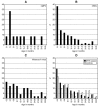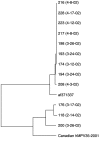Human metapneumovirus infections in hospitalized children
- PMID: 12781001
- PMCID: PMC3000156
- DOI: 10.3201/eid0906.030017
Human metapneumovirus infections in hospitalized children
Abstract
We evaluated the percentage of hospitalizations for acute respiratory tract infections in children < or =3 years of age attributable to human metapneumovirus (HMPV) and other respiratory viruses in a prospective study during winter and spring 2002. We used real-time polymerase chain assays and other conventional diagnostic methods to detect HMPV, human respiratory syncytial virus (HRSV), and influenza viruses in nasopharyngeal aspirates of children. HMPV was detected in 12 (6%) of the 208 children hospitalized for acute respiratory tract infections, HRSV in 118 (57%), and influenza A in 49 (24%). Bronchiolitis was diagnosed in 8 (68%) and pneumonitis in 2 (17%) of HMPV-infected children; of those with HRSV infection, bronchiolitiss was diagnosed in 99 (84%) and pneumonitis in 30 (25%). None of the HMPV-infected children was admitted to an intensive-care unit, whereas 15% of those with HRSV or influenza A infections were admitted. HMPV is an important cause of illness in young children with a similar, although less severe, clinical presentation to that of HRSV.
Figures




Similar articles
-
Human metapneumovirus infections in hospitalised infants in Spain.Arch Dis Child. 2006 Apr;91(4):290-5. doi: 10.1136/adc.2005.082388. Epub 2006 Jan 6. Arch Dis Child. 2006. PMID: 16399780 Free PMC article.
-
Human metapneumovirus and respiratory syncytial virus in hospitalized danish children with acute respiratory tract infection.Scand J Infect Dis. 2004;36(8):578-84. doi: 10.1080/00365540410018166. Scand J Infect Dis. 2004. PMID: 15370669
-
Human metapneumovirus infection in young children hospitalized with acute respiratory tract disease: virologic and clinical features.Pediatr Infect Dis J. 2008 May;27(5):406-12. doi: 10.1097/INF.0b013e318162a164. Pediatr Infect Dis J. 2008. PMID: 18382388
-
Human metapneumovirus.Semin Respir Crit Care Med. 2011 Aug;32(4):447-53. doi: 10.1055/s-0031-1283284. Epub 2011 Aug 19. Semin Respir Crit Care Med. 2011. PMID: 21858749 Review.
-
Clinical impact and diagnosis of human metapneumovirus infection.Pediatr Infect Dis J. 2004 Jan;23(1 Suppl):S25-32. doi: 10.1097/01.inf.0000108190.09824.e8. Pediatr Infect Dis J. 2004. PMID: 14730267 Review.
Cited by
-
Interferon Epsilon-Mediated Antiviral Activity Against Human Metapneumovirus and Respiratory Syncytial Virus.Vaccines (Basel). 2024 Oct 21;12(10):1198. doi: 10.3390/vaccines12101198. Vaccines (Basel). 2024. PMID: 39460364 Free PMC article.
-
Epidemiology of human metapneumovirus in Taiwan from 2013 to 2023.Arch Virol. 2024 Oct 23;169(11):229. doi: 10.1007/s00705-024-06147-8. Arch Virol. 2024. PMID: 39441325 Free PMC article.
-
Exploring Clinical Predictors of Severe Human Metapneumovirus Respiratory Tract Infections in Children: Insights from a Recent Outbreak.Microorganisms. 2024 Mar 23;12(4):641. doi: 10.3390/microorganisms12040641. Microorganisms. 2024. PMID: 38674586 Free PMC article.
-
Respiratory Viral Coinfections: Insights into Epidemiology, Immune Response, Pathology, and Clinical Outcomes.Pathogens. 2024 Apr 12;13(4):316. doi: 10.3390/pathogens13040316. Pathogens. 2024. PMID: 38668271 Free PMC article. Review.
-
A tale of two fusion proteins: understanding the metastability of human respiratory syncytial virus and metapneumovirus and implications for rational design of uncleaved prefusion-closed trimers.bioRxiv [Preprint]. 2024 Mar 8:2024.03.07.583986. doi: 10.1101/2024.03.07.583986. bioRxiv. 2024. PMID: 38496645 Free PMC article. Preprint.
References
-
- Taxonomy V. Seventh report of the International Committee on Taxonomy of Viruses. San Diego: Academic Press; 2000.
Publication types
MeSH terms
LinkOut - more resources
Full Text Sources
Other Literature Sources
